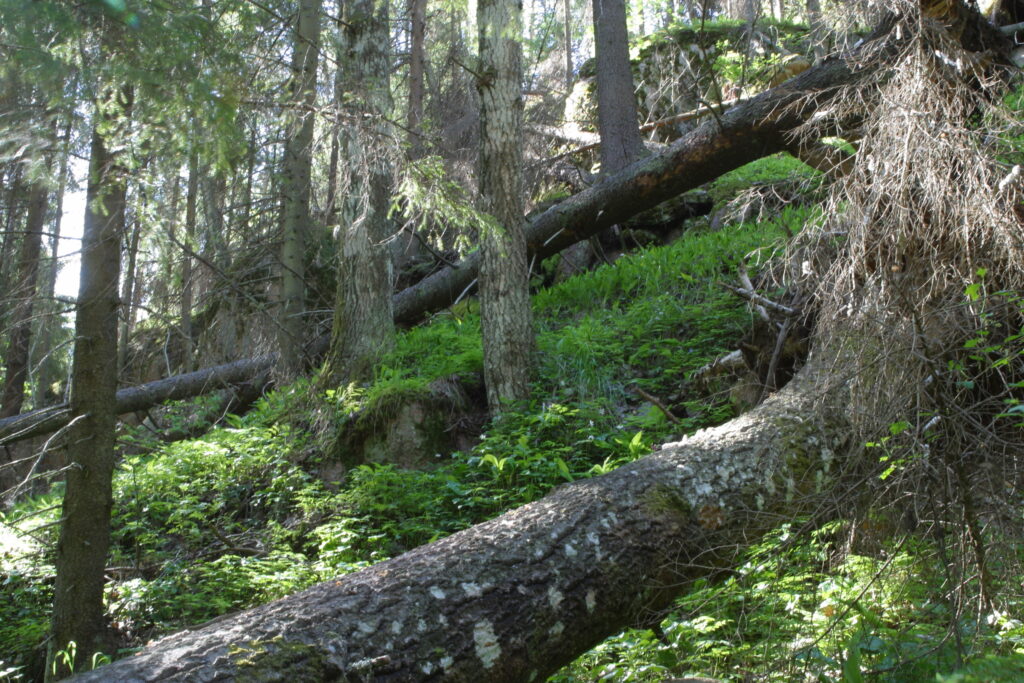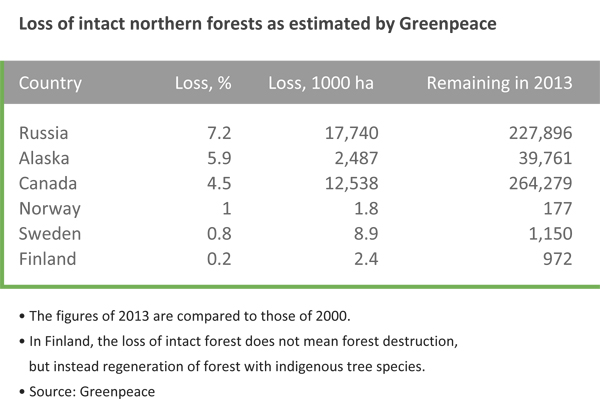Loss of ”great northern forest” smallest in Finland, says Greenpeace

The country that fares worst in the estimate is Russia: according to Greenpeace, it is responsible for half of the northern forests loss. The total area of intact forests in Finland as evaluated by Greenpeace is much smaller than that of strictly protected forests in Finland.
One of the background documents of Greenpeace’s Great Northern Forest campaign is the map of Intact Forest Landscape areas from 2006. The organization has now estimated how much of these forests have been lost between 2000 and 2013.
Finland does very well in these estimates. Proportionately, the loss is the smallest in Finland, only 0.2 percent.
As estimated by Greenpeace, there were some 972,000 hectares of intact forests in Finland in 2013. This is a good deal less than the strictly protected forest area in Finland, which the Natural Resources Institute Finland sets at 2,627,000 hectares. The total forest area of Finland is some 23 million hectares.
The countries or states that fare the worst in the Greenpeace estimate are the Russian Federation, Alaska and Canada. As regards forestry in Russia, Greenpeace compares it to mining, which pays no attention to the regeneration of forests.
On the other hand, neither does the organization approve of the Nordic methods of forestry with thinnings and regeneration, seeing it, too, as a threat to Russian, as well as Nordic forests. According to another ENGO, the WWF, Nordic forestry is not a threat to Russian forests and would be a better method than the current one.
It is also worth noting that Greenpeace leads us to believe that the loss of IFL forests equals total forest loss. However, this is not the case in Finland, where a new forest consisting of natural and indigenous species must be established after harvesting.

Almost all IFL areas excluded from forestry in Finland
A look at Greenpeace’s IFL maps from 2006 shows that Finland has responded well to the challenge set by them. Of all the areas then defined as IFLs in Finland, 99 percent are excluded from commercial use.
Not all of these areas are officially protected, although the decisions not to use these forests are practically as binding as strict protection. However, this is something that the Finnish forest sector and Greenpeace disagree, as Greenpeace considers that only statutory strict protection is worth mentioning.
There is also an extensive network of areas in state-owned commercial forest that are permanently excluded from forestry to support the official protection network. “In addition to this, occurrences of threatened species and flying squirrel as well as the nests of birds of prey surrounded by protection zones are excluded from forestry,” says Mr. Antti Otsamo, Sustainable Development Manager of the state forestry company Metsähallitus Forestry.
Otsamo points out that the majority of threatened forest species also survive in commercial forest, thanks to retention trees and protection zones created in connection with loggings, for example.
Most of the IFL areas in Finland are state-owned. As to private IFL lands, they are often very small areas surrounded by state-owned lands, mostly consisting of plots of land around permanent dwellings or summer cottages.
The term intact forest landscape was developed by a group of ENGOs. They define it as an unbroken natural landscape of a forest ecosystem and its habitat.
Map of IFL areas in Finland (scroll down to see the English texts)

Kirjoita kommentti